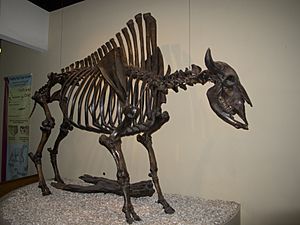Antique bison facts for kids
Quick facts for kids Antique bisonTemporal range: Pleistocene
|
|
|---|---|
 |
|
| Bison antiquus | |
| Conservation status | |
|
Fossil
|
|
| Scientific classification | |
| Kingdom: | |
| Phylum: | |
| Class: | |
| Order: | |
| Family: | |
| Genus: | |
| Species: |
B. antiquus
|
| Binomial name | |
| Bison antiquus Leidy, 1852
|
|
Bison antiquus, often called the "ancient bison," was a very common large plant-eating animal. It lived in North America for over ten thousand years during a time called the Pleistocene epoch. This ancient bison is a direct ancestor of the American bison we see today.
Contents
Meet the Ancient Bison
The Bison antiquus was one of the most common large animals in North America. It was a herbivore, meaning it ate only plants, mostly grasses. Imagine a giant version of today's bison, roaming vast grasslands!
When Did It Live?
The ancient bison lived during the Pleistocene epoch. This period is also known as the Ice Age. It lasted from about 2.6 million years ago to about 11,700 years ago. Bison antiquus was around for a big part of that time.
Where Did It Roam?
These powerful animals lived across much of North America. Their fossils have been found from what is now Alaska down to Mexico. They preferred open grasslands and plains, much like modern bison.
How Big Was It?
Bison antiquus was quite large. It was bigger than the American bison we know today. Scientists believe it could weigh over 3,500 pounds (1,600 kg). It also had longer horns than modern bison. These horns could spread up to 7 feet (2.1 meters) wide!
What Did It Eat?
Like all bison, the ancient bison was a grazer. This means its diet mainly consisted of grasses. It used its strong jaws and teeth to chew tough plant material. They helped keep the ancient grasslands healthy.
Life in the Ice Age
The Pleistocene epoch was a time of big changes. Glaciers covered large parts of the Earth. But between these icy periods, there were warmer times. This allowed grasslands to grow, providing food for animals like Bison antiquus.
Surviving the Cold
Bison antiquus was well-suited for its environment. Its thick fur would have protected it from cold temperatures. Its large size also helped it stay warm. These adaptations were key to its survival.
Interactions with Other Animals
The ancient bison shared its home with many other large animals. These included mammoths, mastodons, and saber-toothed cats. It was an important part of the Ice Age ecosystem.
Hunters of the Past
Early humans also lived during the Pleistocene. They likely hunted Bison antiquus for food and hides. Evidence of these hunts has been found at ancient sites. This shows how humans and bison lived together.
Why Did It Disappear?
Bison antiquus went extinct around 10,000 years ago. This happened at the end of the last Ice Age. Many other large animals also disappeared around this time.
Climate Change's Role
One main reason for its extinction was climate change. The Earth started to warm up, and the glaciers melted. This changed the grasslands that Bison antiquus depended on. New types of plants grew, and their food source became less common.
Impact of Humans
Some scientists believe that hunting by early humans also played a role. As human populations grew, they might have put more pressure on bison numbers. It was likely a combination of factors that led to their disappearance.
Legacy of the Ancient Bison
Even though Bison antiquus is extinct, its legacy lives on. It is the direct ancestor of the modern American bison. Studying its fossils helps us understand the past. It also teaches us about how animals adapt to changing environments.
Studying Fossils
Scientists learn about Bison antiquus by studying its fossils. These include bones, teeth, and horns. Fossils tell us about their size, diet, and how they lived. They also help us understand ancient climates.
Connecting Past to Present
The story of Bison antiquus reminds us how connected life is. The challenges it faced, like climate change, are still important today. Protecting modern bison helps us remember their ancient relatives.
Images for kids
See also
 In Spanish: Bison antiquus para niños
In Spanish: Bison antiquus para niños


